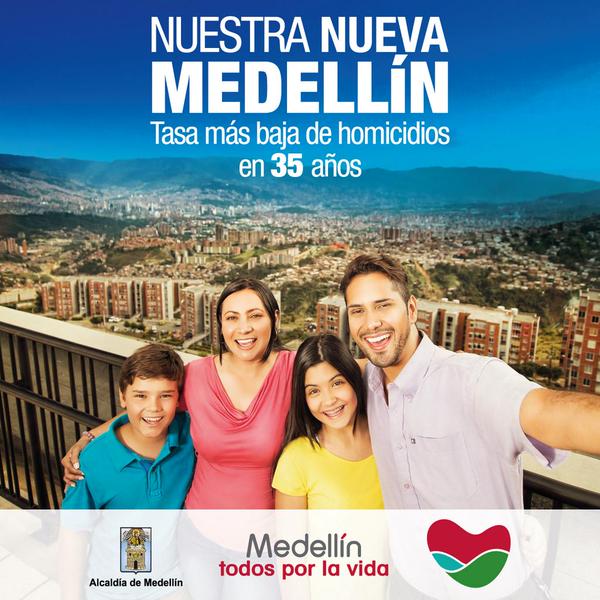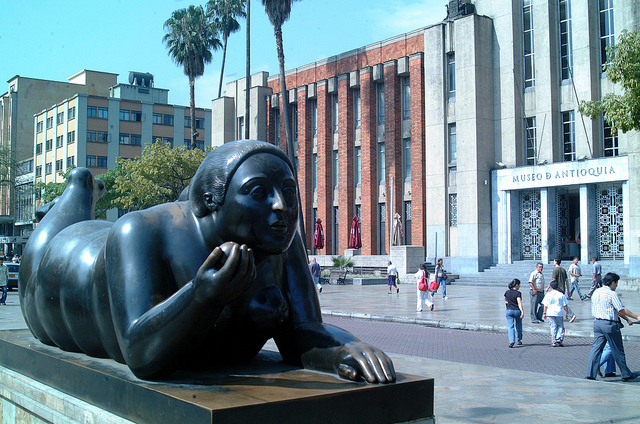
At every major turnpike in Medellin there’s a sign that reads, “Nuestra Nueva Medellin” (our new Medellin), part of a larger national campaign aimed at improving Colombia’s image. Happy-go-lucky posters of smiling families and couples on bike rides with words like ‘sostenible’ or ‘saludable’ adorn subway stations and public plazas. And perhaps they’re paying off, in the last six months alone travel junkies from Condé Nast to nytimes have published several articles lauding the city’s transformation. In just under a decade Medellin has gone from murder capital to backpacker haven.
 One of the many "Nuestra Nuestra Medellin" ads
One of the many "Nuestra Nuestra Medellin" ads
A nationwide crackdown on crime entitled ‘seguridad democrática’ (democratic security) made former President Álvaro Uribe the darling of Western media. And his successor, Juan Manuel Santos is maintaining a similarly tough stance on corruption and security. Human rights groups have fiercely criticized these policies, claiming the heavy-handed nature of the campaigns came at too great a cost. Still improvements in public security and safety are evident here in Medellin, most notably in the form of public works projects.
Residents of the city’s hillside slums previously condemned to a two-hour commute can now hop a cable car that for 2,000 pesos (approximately 80 cents) will ferry them into the heart of Medellin. The metro was expanded in 2010 both westward and southbound to include the surrounding townships outside of Medellín proper. And as of yesterday the city began testing a light rail that will connect the center to the eastern suburbs.
These renovations and upgrades have earned Medellin a reputation as a center for urban ingenuity. In 2013 the Urban Land Institute named it the world’s most innovative city.
Moreover there has also been a focus on improving public spaces. In 2004 Fernando Botero donated 23 of his sculptures as part of a project to renovate the Museum of Antioquia. The pudgy figurines have created a playful atmosphere in downtown Medellin, which since the 90’s has had a reputation as a magnet for seedy activity. Estadio, an Olympic sports complex built in the 1950’s, underwent a massive renovation in 2010 and now serves hundreds of residents who use the facilities free of charge.
 Botero Plaza: Photocredit Guia de Viajes Oficial de Medellín @flickr
Botero Plaza: Photocredit Guia de Viajes Oficial de Medellín @flickr
Institutions aimed at reconciling with Colombia’s decades long conflict have emerged, La Casa de la Memoria (house of memories), constructed in 2011, is both a museum and research center dedicated to helping Colombian society confront its tumultuous past and present.
But the starry-eyed tripadvisor review I’d begun drafting was thoroughly unraveled when I prompted locals on the subject of Medellin’s ‘transformation’. While they all agreed the situation was vastly improved they felt the slogan was premature. As one neighbor relayed to me, “We’re still one of the most unequal countries in the world, we still have slums, the drug trade still prospers, [Pablo] Escobar’s death and Uribe’s policies didn’t change that”. Another added, “Improving public security hasn’t improved opportunity here, that’s the next step.”
I feel the presence of this dichotomy constantly. The hour-long metro ride from my neighborhood in La Floresta to where I work in Madera is the perfect example of it. It begins in a lush middle-upper class suburb; I change in the center, which is unanimously working class, and disembark at Madera an area known for slums where many of my borrowers live.
In Floresta there are modern supermarkets, cafes with prices on par with San Francisco, and ubiquitous neighborhood security. By the time I reach Madera the scene is drastically different; high rises and slums dot the hillside landscape, evangelicals recruit on the side of the road, and it strikes you as the kind of place you’d rather not linger.
At this point I side with my neighbors-- the city is visibly improved, but not for everyone.
PREVIOUS ARTICLE
Photos From the Field: Fellows share their favorite shots! →NEXT ARTICLE
A Fish Full of Dollars →













